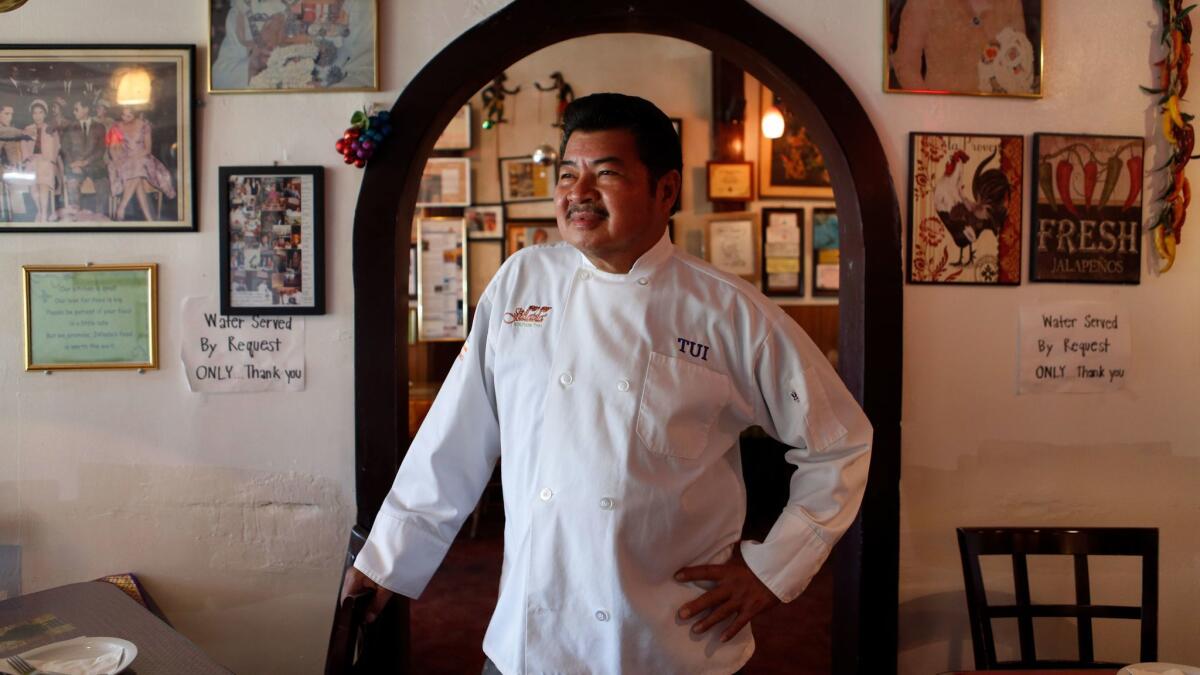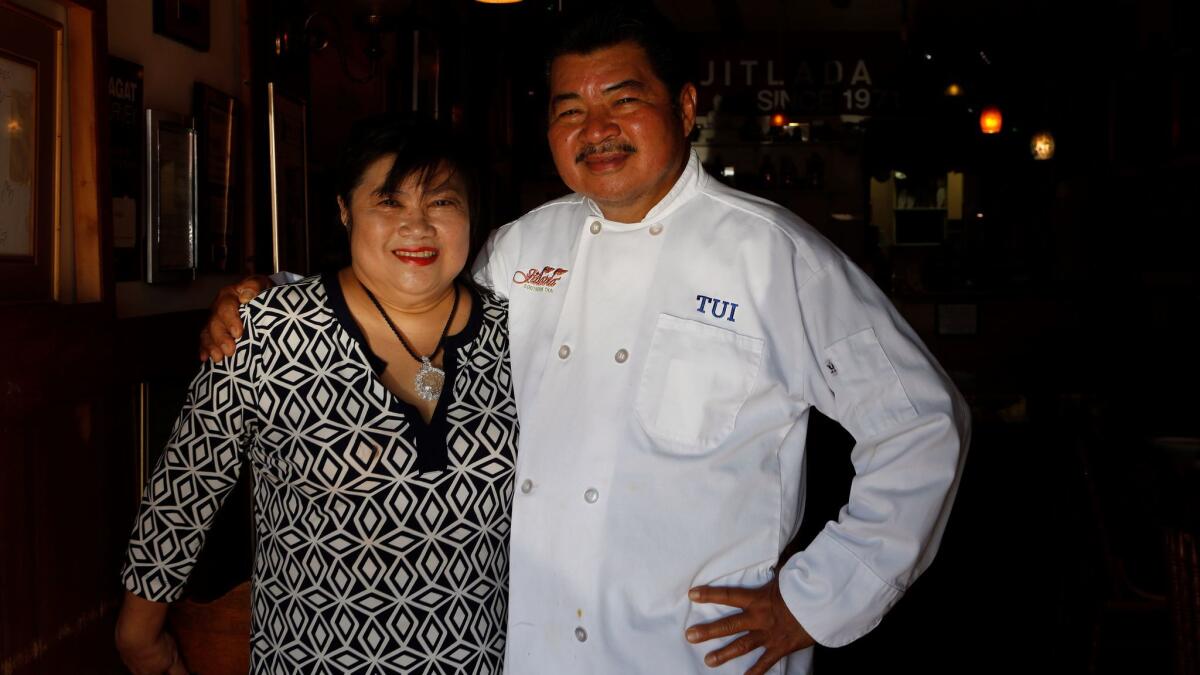Appreciation: Jitlada’s Tui Sungkamee helped popularize the idea of regional cooking

- Share via
Even before Tui and Jazz, Jitlada was one of the most respected Thai restaurants in Los Angeles. Opened in the 1970s — a cozy Hollywood dining room known for well-made seafood, gentle curries and carved-vegetable garnishes that alluded to royal court cuisine — it was the restaurant Thai friends recommended before they knew whether or not you were up to the heat and stink of the bawdier sorts of Thai cooking. It may be where you first experienced pad Thai or chicken-coconut soup.
But if you had visited Jitlada in 2007, not long after it was bought by chef Suthiporn “Tui” Sungkamee and his sister, Sarintip “Jazz” Singsanong, you might have thought you had wandered into a different place. The Thai wood carvings were still on the walls, but it seemed as if half the customers were clutching translated menus they’d downloaded from the internet. And instead of chicken satay on the tables, there were herb-zapped plates of rice salad from Thailand’s jungly tail, beef simmered with pickled buds from the cassia tree, and curries made with dried mudfish, sour tamarind shoots or fresh fish kidneys. The most popular dishes seemed to be turmeric-yellow fried sea bass, a severely spicy mango salad flavored with coconut milk, and fish balls formed around salted duck egg yolks.
Tui was quiet; Jazz was loud. Tui presented his dishes with a shy smile; Jazz told you they were the best thing you would ever eat. Tui would mention a new herb he managed to bring in from Thailand; Jazz would steer you toward what she knew you already loved. For years, a plastic-encased list of my recommendations adorned most tables — at any other restaurant, I would have complained.

The restaurant, which quickly became the object of obsession among chefs, film people and the online food community, also helped popularize the idea of regional cooking — that a chef could specialize in the cooking of a specific area, in this case southern Thailand, without feeling obligated to represent the cuisine of an entire nation.
And the vibrancy of Sungkamee’s approach to strong southern flavors proved that Thai chefs didn’t have to cook for some imagined non-Thai customer. They could be just as successful cooking for themselves. He died of lung cancer last week, but his influence is likely to linger for quite a while. There is an entire generation of chefs in Los Angeles — including Cassia’s Bryant Ng, Night + Market’s Kris Yenbamroong and perhaps Broken Spanish’s Ray Garcia — whose success might be less possible without Sungkamee’s example.
Jitlada’s strong following among chefs is not an accident. But the restaurant’s transformation perhaps was.
On a lark, in his first months at Jitlada, Sungkamee had printed a list of southern Thai dishes, in untranslated dialect, on the back page of the takeout menu. A visiting food enthusiast found a stack of takeout menus in the lobby of his Hollywood hotel and wrote a long post translating the specialties for the Chicago-based restaurant site LTHforum under the name “Erik M.’’ I reviewed the restaurant not long afterward, focusing on the mephitic intensity of the southern Thai untranslated dishes.
Lines began to form in the evenings — not for the tame dishes that the menu continued to feature, but for previously unapproachable regional specialties. People were eager to try the pickled crab, the turmeric fish and the shredded catfish salad. Some people speculated that Ryan Gosling may have eaten at Jitlada more often than he dined at home.
Sungkamee’s death was a huge loss to Jitlada and the Thai community. (The restaurant will continue under Singsanong and other family members, some of whom had been cooking with Sungkamee for years.) But he influenced Los Angeles restaurants in ways that go beyond his gift for balanced flavors and punches of spice.
There was always someplace to find yourself on the makeshift list of southern specialties attached to the back of Jitlada’s menu — a list that swelled to almost 400 — even if you were vegan, avoiding carbs or suspicious of new flavors. Jitlada’s cult quickly grew beyond the usual band of Thai-restaurant enthusiasts. In a way, it may have been the first Los Angeles restaurant of the internet era.
Sungkamee was not the first Thai chef with a celebrity following in Los Angeles; he wasn’t the first to prepare southern dishes, and he wasn’t even the first to get attention for an untranslated list of specials.
He grew turmeric and other Thai herbs when they weren’t available in markets, but so have a lot of other chefs. His kua kling phat tha lung was probably the spiciest dish available in Los Angeles at the time, a turmeric-rich beef curry that pinned your nervous system far into the red. But a lot of chefs have made exceedingly hot food. It was always a pleasure to run into him in the Thai market LAX-C, eyeing coconuts and jackfruit with the concentration you sometimes see in a neuropathologist peering at a slide, but it’s always fun to see a great chef looking at produce.
Posts on Yelp and Chowhound didn’t talk about pad Thai or chicken satay, but fried dried mullet, acacia omelets and those hallucinatory southern curries, the coco-mango salad and mussels in spicy broth, the savories wrapped in betel leaves and soft-shell crabs fried with strong-smelling sator beans.
The real importance of Sungkamee may be that at a time when it was assumed that non-Thais preferred sweet, crunchy food, that only people brought up on the cuisine could tolerate the unusual seasonings and the funk, his cooking inspired his customers to go beyond the long menu of the usual Thai dishes to discover the challenging food of his native region — to embrace the ideas of regionality, unusual spices and challenging flavors themselves.
More to Read
Eat your way across L.A.
Get our weekly Tasting Notes newsletter for reviews, news and more.
You may occasionally receive promotional content from the Los Angeles Times.










